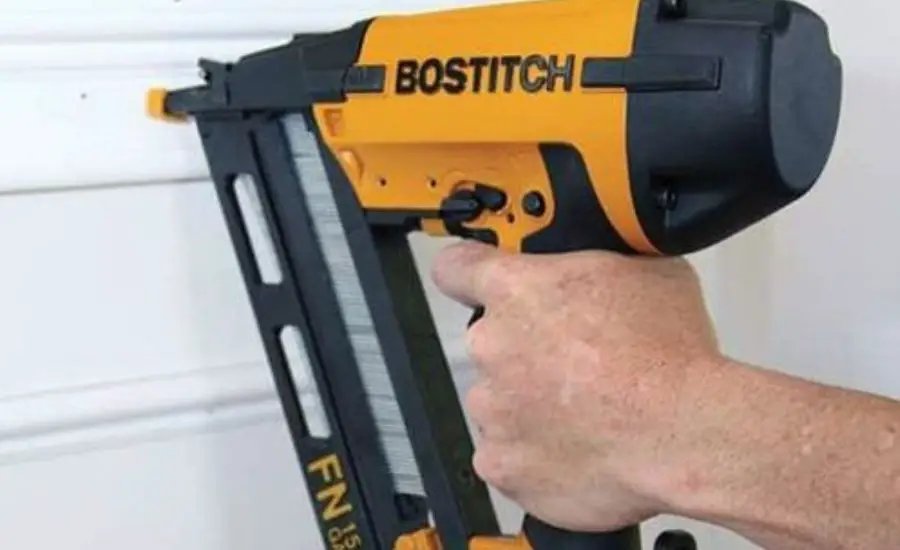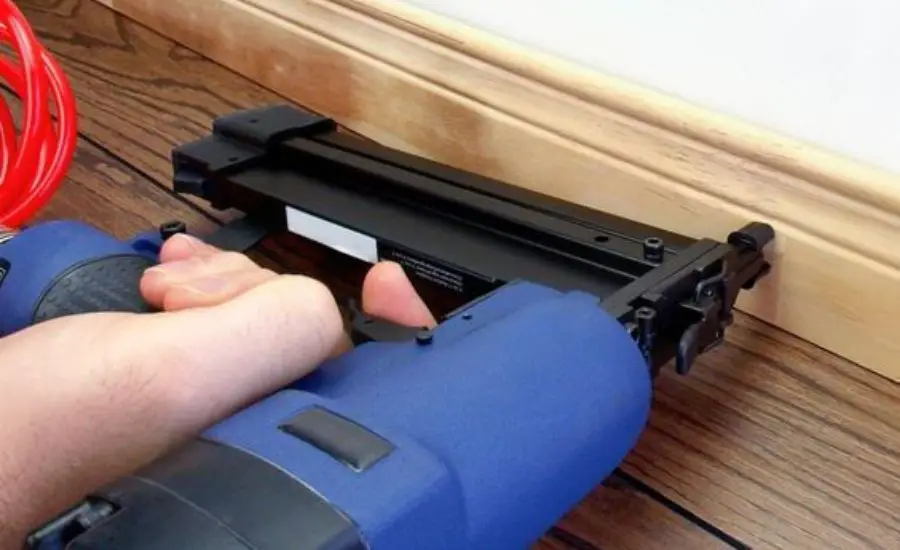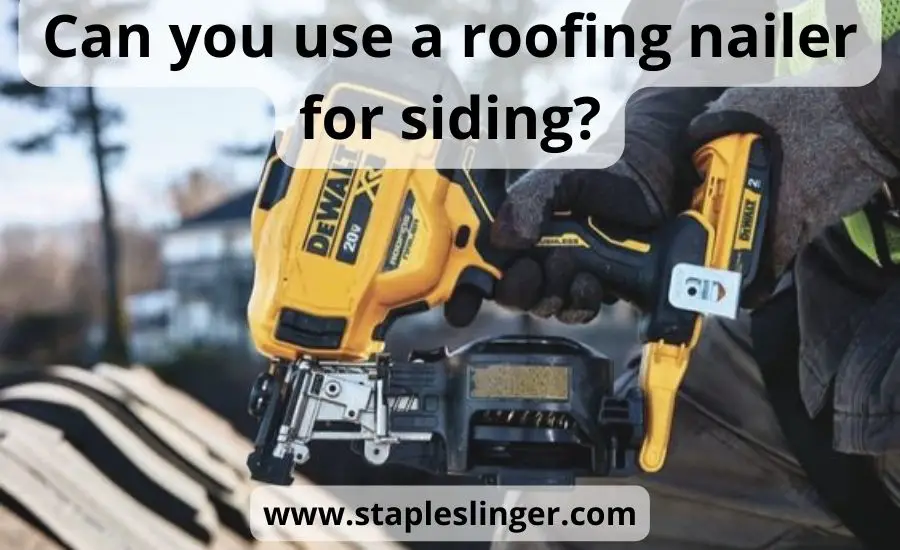Can you use a roofing nailer for siding: overview
Let’s say you are installing siding in your home. However, you soon discover that you have a roofing nailer rather than a siding nailer. Furthermore, you are not in a position to purchase a siding nailer. What should you do next? The thought “Can you use a roofing nailer for siding?” may have crossed your mind.

Siding nailer
A siding nailer is a particular kind of nail gun that is used only for siding tasks, as its name already makes clear. Although they are much more precise, they operate similarly to framing nails enabling you to address issues like nail head piercing and the excessive force experienced while using framing nailers.
Siding nailers are excellent equipment for rubber domes and wood, providing solutions for all siding projects and leaving a perfect appearance.
You can use coil nails with a siding nailer, which cuts down on refilling time. Numerous siding nailers feature an air filter to assist in decreasing dust. They frequently include a wide range of depth adjustments, allowing you to modify with various connecting material sizes.
A siding nailer is a particularly adaptable piece of equipment, in addition to its portability. In terms of siding performance, the siding nailer is completely unrivaled.
You could certainly accomplish the same task using a framing nailer, but the result would not be flawless.
You can execute bump shots or single shots with a siding nailer. You will avoid getting shot if you do this. Since the majority of siding nailers feature a trigger lock system, they are secure when in use.
However, they are only appropriate for siding projects and not ideal for any other nailing tasks. They should typically be applied to a soft wall to achieve the best results.
Roofing nailers
Roofing nailers are different from the various kinds you’ve typically seen. Regardless of if you are replacing or installing a new roof, roofing nailers are specifically made for the job at hand.
The most popular and commonly used roofing nailers are pneumatic roofing nailers.
The function of roofing nails, however, is to make it simple to remove the shingles when it’s time to replace them, whether it’s right away or later.
A detailed comparison of siding and roofing nailers
I’m hoping that after reviewing the comparison below, all of your misunderstandings about whether you can use a roofing nailer for siding get cleared up and you’ll be able to select the best tool.
Nail
The primary distinction between roofing nailers and siding nailers is the type of nails they are designed to shoot. You are required to replace the roof of your house after two decades because roofing shingles are only designed to survive that long. Natural disasters or bad weather can also damage roof shingles, shortening the time between re-roofings.
This is how roofing nails are created. They often have a broad head and a smooth shank instead of a ring shank, making them simple to draw out as required.
However, because the roofing material is frequently thin, they are not required to be sufficiently long. Nonetheless, they must possess enough punching force and strength to effortlessly pierce the composite or fiber cement shingles.
While roofing materials need frequent maintenance, siding materials are made to survive for a very long period.
Another thing we note is that siding nails also typically have a galvanizing coating to prevent corrosion, just like roofing nails. Hot-dip galvanized siding nails are stronger and more durable. There are different kinds of siding nails, including aluminum and galvanized siding nails. Siding nails are available in a variety of designs, as opposed to roofing nails.
Design
They are made to do various things, yet have the same operating principles and design. Exterior sidings including wood siding, vinyl siding, or fiber cement siding are fastened with siding nailers, which resemble coil framing nailers. Since they are often robust yet lightweight, they may firmly secure the siding material and shoot nails into it.
Weight
Siding nailers are still considered to be handheld power tools, even though an air compressor must always be connected to these pneumatic siding nailers. As a result, when thinking about purchasing a siding nailer, its size and weight are rather important variables.
A small and compact siding nailer takes up less room in your toolbox and may be utilized without difficulty in all confined spaces.
The weight of a sliding nailer can also be more useful if it is light, much like its size. As opposed to a heavier model, any lightweight siding nailer can be operated continuously for a longer amount of time without experiencing any arm fatigue. Furthermore, a siding nailer comes with ergonomic and comfy hand handles.
Warranty
It’s crucial to check the siding nailer guarantee duration to confirm the dependability of the specified model. While the majority of options have a 3- or 5-year warranty, more dependable solutions may even have a 7-year warranty because the company that makes siding nailers stands behind their product.
Safety precautions
Safety must always come first in using siding nail guns. Don’t forget to cover your ears, put on goggles, and wear a dust mask when working.
Verify that the nail gun is set up correctly for the kind of siding you’re using, including the appropriate depth and pressure, before using it.
Keep your hands and fingers away from the tool’s firing region and avoid putting them in front of the muzzle.
Ensure that the siding nailer is off and unplugged from the power outlet before reloading it. When reloading, point the weapon away from you and any nearby people. And lastly, once the task is done, put the nail gun away in a secure location that is beyond the reach of kids and animals.
How to use roofing nailers for siding
Using a nailer with adjustable depth
Utilize a roofing nailer with a variable driving depth. There is often a predetermined driving depth on roofing nailers. Because of this, siding is rarely fastened with roofing nails.
Find a roofing nailer with adjustable depth if you intend to use it for siding. To ensure that the nail placement is precise, you must carefully handle the equipment. This will make it possible to install siding on the surface properly.
Vinyl siding installation
Nails used on vinyl siding are only around 1-3/4 inches long. That length of nail works well with a roofing nail gun. It can therefore be used to apply vinyl siding.
In addition, installing vinyl panels requires a lot of nailing. Since roofing guns discharge nails more quickly than siding guns, they may make the work more accessible.
Nevertheless, using vinyl panels to attach them is more difficult than using roofing nails. Plastic is the primary component of vinyl paneling.
They need to be tied loosely, as they deform with temperature changes.
The roofing nailer can be fitted with a unique adaptor that allows for simple attachments. This adaptor allows roofing nail guns to perform flawlessly with vinyl.

If you’re looking for an affordable roofing nailer, you might be unsure whether the Dewalt model would meet your requirements. This roofing nailer is adaptable and suitable for a range of tasks. This roofing nailer is undoubtedly a useful tool, but siding is not the best application for it.
Since most siding applications require thicker nails, the maximum nail diameter of the Dewalt roofing nailer is insufficient. You cannot use the ring or spiral shank nails intended for siding applications with the Dewalt roofing nailer since it only accepts smooth shank nails.
This roofing nailer is a fantastic tool for the job it was designed to do, but siding is not a good fit for it. Search somewhere else if you need a flexible instrument that can work with both thin and thick siding materials. The Dewalt model, though, should be adequate if all you want is a high-quality roofing nailer.
It is not advised to use roofing nails for Hardie siding. Even though they are readily available and inexpensive, roofing nails are not intended for use with Hardie siding and may cause several issues, including harm to the siding, significant safety risks, and a reduced lifespan of the installation.
No, a roofing nail gun is not appropriate for thinner materials like vinyl siding because it is made for heavier materials like asphalt shingles. You stand the risk of hurting yourself if you attempt to install it with a roofing nailer. We advise using a pneumatic framing nailer for the majority of do-it-yourself vinyl siding applications.
Using a manual hammer and nails is a completely feasible and economical alternative to utilizing a siding nailer, which can be quicker and more comfortable.
This is more adequate for a smaller siding project.
Furthermore, try out siding alternatives that aren’t dependent on nails or a nail gun, including cement board siding that is bolted onto the wall or vinyl siding that snaps into place if the price of siding nails and a nail gun remains too expensive.
The best nailer to install siding is, obviously, a siding nail gun. Using a different kind of nailer might be possible, although the outcome won’t be quite as good.
Conclusion
For optimum siding installation, use a pneumatic roofing nailer with a pressure setting that can be adjusted to make sure the nails are pushed in deep enough. You can use a roofing nailer (galvanized nails) to install siding if you “blind nail” them so the nail head is unseen.
Due to their slightly more substantial length, siding nails cost more than roofing nails. Be mindful that a roofing nailer is bigger and heavier than a siding nailer. So, it’s still not recommended to use a roofing nailer for siding.
I hope this guide on “Can you use a roofing nailer for siding” has been helpful.

